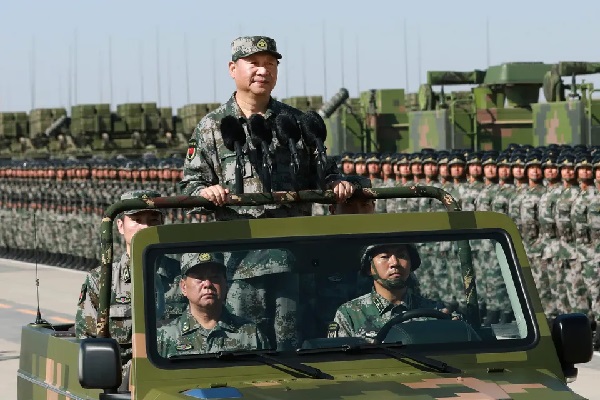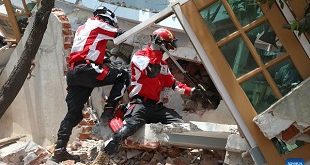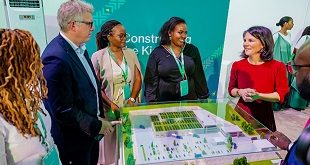
BEIJING | Xinhua | The Chinese People’s Liberation Army (PLA) celebrated its 97th founding anniversary on Thursday.
The past few days have seen President Xi Jinping, also general secretary of the Communist Party of China (CPC) Central Committee and chairman of the Central Military Commission (CMC), engage in a string of activities concerning the military.
He convened a Party leadership study session, calling for modernizing border, coastal and air defense. He wrote back to officers and soldiers of an elite army company with its history dating back to the Red Army days, urging them to strengthen training in real combat conditions.
He also made an instruction on veterans’ affairs, emphasizing the importance of making military service an honorable occupation and ensuring that ex-service personnel enjoy respect from the whole society.
On Thursday, Xi’s article on modernizing national defense and the armed forces was published by Qiushi, a flagship Party magazine.
In the article, Xi said developing the people’s army into a world-class military at a faster pace is a “strategic task” for building a modern socialist country in all respects.
He said the military’s political integrity must be enhanced and the military should be strengthened through reform, development of science and technology, as well as talent cultivation.
PRESERVE POLITICAL INTEGRITY
In the Qiushi article, Xi said “the barrel of the gun” should always follow the Party’s order, echoing Chairman Mao’s most famous dictum — “political power comes from the barrel of a gun.”
Since its founding 97 years ago, the PLA has always acted and fought under the Party’s absolute leadership. Precisely due to this steadfast guidance, the PLA has grown from nothing into a strong force.
“History tells us that ‘the Party commands the gun’ is a basic guarantee to ensure the people’s army maintains its essential nature and aim,” Xi once said.
In June, Xi convened a pivotal political work conference of the armed forces in Yan’an, an old revolutionary base where the Red Army was stationed about 90 years ago after the Long March. It was in Yan’an that Mao led the people’s army to regain its strength and fight the wars that led to the founding of the People’s Republic of China in 1949.
In Yan’an, Xi emphasized the need to uphold the Party’s absolute leadership over the military and to build a high-quality team of cadres that is loyal, clean, responsible and capable.
Since becoming China’s top leader, Xi has taken steps to address concerns over weakened Party leadership in the military, an issue that people feared could undermine combat effectiveness and threaten the fundamental political principle that the Party commands the military.
Over the years, the political climate within the military has improved significantly through the full implementation of the system of ultimate responsibility resting with the CMC chairman, along with advancements in integrity building and anti-corruption efforts, and adoption of other measures.
STRENGTHEN THE MILITARY THROUGH REFORM
In mid-July, a pivotal Party resolution adopted at the third plenary session of the 20th CPC Central Committee reiterated the importance of strengthening the military through reform to ensure the realization of the PLA’s 2027 centenary goals.
Reform has been the key theme as Xi has reshaped the armed forces over the past decade.
Major changes have taken place within the armed forces since late November 2015, when Xi convened a key meeting in Beijing to launch “the most extensive and profound reform of national defense and the armed forces” since 1949.
The PLA has dismantled long-established systems of general departments and military area commands, altered the dominance of land forces within the overall force composition, and established new leadership, management and operational command systems.
Five theater commands have been established, and services have been rebalanced. The country’s navy and rocket forces have expanded, the number of non-combat personnel has been reduced and combat forces have grown.
The proportion of land forces in the military has dropped to below 50 percent, nearly half of all non-combatant organization personnel have been removed, and the number of officers has been reduced by 30 percent.
The PLA now has a system of services that comprises the army, navy, air force and rocket force, with branches including the country’s aerospace force, cyberspace force, information support force and joint logistics support force.
During exercises and training, previously independent military units across different services now conduct joint operations under a theater command. Previously isolated information is now circulated efficiently among various military units within theater commands.
In the latest structural reform, the PLA’s information support force was established and commenced in April.
Zhang Youxia, a CMC vice chairman, said the move, initiated by Xi, was to address “the most pressing need” to reshape the network information system and let it better empower joint military operations.
In the reform-themed resolution adopted in July, China’s leadership again pledged to “deepen the reform of joint operations systems” and “refine the functions of the CMC command center for joint operations” to enhance combat capabilities.
WORLD-CLASS ARMED FORCES FOR PEACE
As reshaping continues within the military, the PLA’s strength has increased significantly, bringing it closer to the goal of fully transforming into a world-class military by the mid-21st century.
With new types of combat forces, such as those related to strategic early warnings, long-range strikes, strategic delivery and information support strengthened, a joint combat force system primarily composed of elite forces has taken shape.
On May 23, the PLA launched drills around Taiwan Island as a strong punishment for the separatist acts of “Taiwan independence” forces and a stern warning against the interference and provocation by external forces.
The drills, carried out by the Eastern Theater Command, were a typical case of joint operation that involves the participation of the army, navy, air force, rocket force and other units.
Such drills focus on joint sea-air combat-readiness patrols, joint precision strikes on key targets, and the joint, comprehensive seizure of battlefield control. The drills involved vessel and aircraft patrols around the island of Taiwan, and integrated operations within and outside of the island chain to test the command’s joint real-combat capabilities.
Military experts say the May drills have demonstrated the Chinese military’s coordination abilities and overall combat strength in joint operations after its reform.
While improving its military, China’s commitment to the path of peaceful development and its pursuit of a national defense policy that is defensive in nature remain unchanged.
When the PLA celebrated its 90th anniversary in 2017, Xi stated that the Chinese military would always be a staunch force in maintaining world peace.
One often-cited example is China’s role in UN peacekeeping operations. Since 1990, China has dispatched more than 50,000 peacekeepers to over 20 countries and regions, including Cambodia, the Democratic Republic of the Congo, Liberia, Sudan, South Sudan and Mali.
In 2015, Xi shared the story of a female peacekeeper named He Zhihong who died in the line of duty while serving in a UN peacekeeping mission in Haiti.
Xi cited a poem written by the late peacekeeper that reads “In this vast world, I may be just like a small feather. But even so, I want this feather to carry the wish for peace.”
“This was her wish, and it is also China’s commitment to peace,” Xi said.
In his latest Qiushi article, Xi once again stated the peaceful nature of the PLA, no matter how strong it becomes.
“The PLA has the confidence and capabilities to safeguard China’s sovereignty, unity and territorial integrity, to provide strategic support to the realization of the great rejuvenation of the Chinese nation, and to make greater contributions to world peace and development,” he said. ■
 The Independent Uganda: You get the Truth we Pay the Price
The Independent Uganda: You get the Truth we Pay the Price



